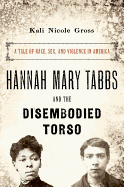
When Kali Nicole Gross (Colored Amazons) came across the case of an unusual 1887 Philadelphia murder, she found a story with many layers. In Hannah Mary Tabbs and the Disembodied Torso: A Tale of Race, Sex, and Violence in America, she explores the intricacies of that case and its implications on criminal justice, a culture of violence and conceptions of race and gender.
Hannah Mary Tabbs was an unusual post-Reconstruction black woman--she unabashedly pursued sex outside of marriage and used violence and physical threats to make a reputation for herself in her black community in Philadelphia's Seventh Ward. In the white community, meanwhile, she upheld the idea of womanly virtue and subservience to her white employers. Gross argues that this manipulative, variable representation of herself allowed Tabbs to almost get away with a serious crime. Tabbs had a lover whose headless, limbless torso turned up on the edge of a pond outside of town. The man convicted for that murder was, Gross contends, a patsy. The skin tones of the various players in this love triangle appear to have played as large a role as their guilt or innocence.
In prose that demonstrates careful research and offers a realistic reconstruction of the crime, Gross comments on social standards for morality and relationships between races and genders. The case of the disembodied torso is not only a sensational piece of true crime, but an opportunity to reflect on these continuing complexities. --Julia Jenkins, librarian and blogger at pagesofjulia

